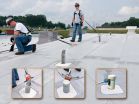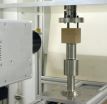(Press-News.org) PASADENA, Calif.—Stretching for thousands of miles beneath oceans, optical fibers now connect every continent except for Antarctica. With less data loss and higher bandwidth, optical-fiber technology allows information to zip around the world, bringing pictures, video, and other data from every corner of the globe to your computer in a split second. But although optical fibers are increasingly replacing copper wires, carrying information via photons instead of electrons, today's computer technology still relies on electronic chips.
Now, researchers led by engineers at the California Institute of Technology (Caltech) are paving the way for the next generation of computer-chip technology: photonic chips. With integrated circuits that use light instead of electricity, photonic chips will allow for faster computers and less data loss when connected to the global fiber-optic network.
"We want to take everything on an electronic chip and reproduce it on a photonic chip," says Liang Feng, a postdoctoral scholar in electrical engineering and the lead author on a paper to be published in the August 5 issue of the journal Science. Feng is part of Caltech's nanofabrication group, led by Axel Scherer, Bernard A. Neches Professor of Electrical Engineering, Applied Physics, and Physics, and co-director of the Kavli Nanoscience Institute at Caltech.
In that paper, the researchers describe a new technique to isolate light signals on a silicon chip, solving a longstanding problem in engineering photonic chips.
An isolated light signal can only travel in one direction. If light weren't isolated, signals sent and received between different components on a photonic circuit could interfere with one another, causing the chip to become unstable. In an electrical circuit, a device called a diode isolates electrical signals by allowing current to travel in one direction but not the other. The goal, then, is to create the photonic analog of a diode, a device called an optical isolator. "This is something scientists have been pursuing for 20 years," Feng says.
Normally, a light beam has exactly the same properties when it moves forward as when it's reflected backward. "If you can see me, then I can see you," he says. In order to isolate light, its properties need to somehow change when going in the opposite direction. An optical isolator can then block light that has these changed properties, which allows light signals to travel only in one direction between devices on a chip.
"We want to build something where you can see me, but I can't see you," Feng explains. "That means there's no signal from your side to me. The device on my side is isolated; it won't be affected by my surroundings, so the functionality of my device will be stable."
To isolate light, Feng and his colleagues designed a new type of optical waveguide, a 0.8-micron-wide silicon device that channels light. The waveguide allows light to go in one direction but changes the mode of the light when it travels in the opposite direction.
A light wave's mode corresponds to the pattern of the electromagnetic field lines that make up the wave. In the researchers' new waveguide, the light travels in a symmetric mode in one direction, but changes to an asymmetric mode in the other. Because different light modes can't interact with one another, the two beams of light thus pass through each other.
Previously, there were two main ways to achieve this kind of optical isolation. The first way—developed almost a century ago—is to use a magnetic field. The magnetic field changes the polarization of light—the orientation of the light's electric-field lines—when it travels in the opposite direction, so that the light going one way can't interfere with the light going the other way. "The problem is, you can't put a large magnetic field next to a computer," Feng says. "It's not healthy."
The second conventional method requires so-called nonlinear optical materials, which change light's frequency rather than its polarization. This technique was developed about 50 years ago, but is problematic because silicon, the material that's the basis for the integrated circuit, is a linear material. If computers were to use optical isolators made out of nonlinear materials, silicon would have to be replaced, which would require revamping all of computer technology. But with their new silicon waveguides, the researchers have become the first to isolate light with a linear material.
Although this work is just a proof-of-principle experiment, the researchers are already building an optical isolator that can be integrated onto a silicon chip. An optical isolator is essential for building the integrated, nanoscale photonic devices and components that will enable future integrated information systems on a chip. Current, state-of-the-art photonic chips operate at 10 gigabits per second (Gbps)—hundreds of times the data-transfer rates of today's personal computers—with the next generation expected to soon hit 40 Gbps. But without built-in optical isolators, those chips are much simpler than their electronic counterparts and are not yet ready for the market. Optical isolators like those based on the researchers' designs will therefore be crucial for commercially viable photonic chips.
INFORMATION:
In addition to Feng and Scherer, the other authors on the Science paper, "Non-reciprocal light propagation in a silicon photonic circuit," are Jingqing Huang, a Caltech graduate student; Maurice Ayache of UC San Diego and Yeshaiahu Fainman, Cymer Professor in Advanced Optical Technologies at UC San Diego; and Ye-Long Xu, Ming-Hui Lu, and Yan-Feng Chen of the Nanjing National Laboratory of Microstructures in China. This research was done as part of the Center for Integrated Access Networks (CIAN), one of the National Science Foundation's Engineering Research Centers. Fainman is also the deputy director of CIAN. Funding was provided by the National Science Foundation, and the Defense Advanced Research Projects Agency.
Caltech-led engineers solve longstanding problem in photonic chip technology
Findings help pave way for next generation of computer chips
2011-08-06
ELSE PRESS RELEASES FROM THIS DATE:
David Blair, QuadCap Wealth Management, and Bond Ladders I
2011-08-06
Bond Ladders, a powerful tool for retirement. A bond ladder works by spreading investment dollars among bonds that will mature at various times between one and fifteen years from now. In a normal interest rate environment, shorter maturities will yield less than longer maturities. Think of the individual bonds as rungs on your ladder. As each individual bond matures, your principal is made available for reinvestment at current interest rates.
The value of a ladder is the ability to reinvest the principal from the maturing bond into a new bond with a higher yield. The ...
Molecular mechanisms offer hope for new pain treatments
2011-08-06
This press release is available in French.
By working with individuals suffering from a severe disorder that causes sensory neurons to degenerate, researchers at the University of Montreal Hospital and CHU Sainte-Justine Hospital have discovered how a specific genetic mutation causes their patients' condition, which in turn has revealed more information about the mechanisms in our bodies which enable us to sense pain. Genetic mutations are mistakes in our genetic code that can either be passed from parents to their children or created when DNA is replicated. Lead author ...
New Miller ShockFusion Permanent Horizontal Lifeline Roof System Features Innovative Surface-Mounted Design
2011-08-06
Honeywell Safety Products announces the new Miller ShockFusion Permanent Horizontal Lifeline (HLL) Roof System - a versatile surface-mounted lifeline system that accommodates most industrial and commercial roof designs including standing seam, membrane, built-up, metal sheathing, concrete and wood.
- Attaches to the surface of existing roof structures - Quick, easy installation reduces costs by requiring minimal labor and eliminating the need for structural roof penetration and repair.
- Significantly reduces system forces on the roof - In the event of a fall, the ...
Better desalination technology key to solving world's water shortage
2011-08-06
New Haven, Conn.—Over one-third of the world's population already lives in areas struggling to keep up with the demand for fresh water. By 2025, that number will nearly double. Some countries have met the challenge by tapping into natural sources of fresh water, but as many examples – such as the much-depleted Jordan River – have demonstrated, many of these practices are far from sustainable.
A new Yale University study argues that seawater desalination should play an important role in helping combat worldwide fresh water shortages – once conservation, reuse and other ...
Researchers find way to help donor adult blood stem cells overcome transplant rejection
2011-08-06
DALLAS – Aug. 4, 2011 – Findings by UT Southwestern Medical Center researchers may suggest new strategies for successful donor adult stem cell transplants in patients with blood cancers such as leukemia, lymphoma and myeloma.
The study, published Aug. 5 in Cell Stem Cell, showed for the first time that adult blood stem cells can be regulated to overcome an immune response that leads to transplant rejection. It also opens up further studies in stem cell immunology, said Dr. Chengcheng "Alec" Zhang, assistant professor of physiology and developmental biology at UT Southwestern ...
Drinking just 1 measure of spirits increases the risk of acute pancreatitis
2011-08-06
Drinking just one 4cl measure of spirits can increase the risk of an acute attack of pancreatitis, but wine or beer does not appear to have the same effect, according to a study published online by BJS, the British Journal of Surgery.
Researchers from the Karolinska Institutet in Sweden followed 84,601 people from 46 to 84 years of age from the general population in Vastmanland and Uppsala for a median of ten years. During that time 513 developed acute pancreatitis.
"Our study revealed a steady increase between each measure of spirits a person drank on one occasion ...
Sexually extravagant male birds age more rapidly, but try to hide it
2011-08-06
For male houbara bustards sexual extravagance is the key to attracting mates in some of the world's harshest desert environments. However, new research in Ecology Letters reveals that males who perform the most extravagant sexual displays will suffer from premature biological aging and will pass their reproductive prime years earlier than their less ostentatious rivals.
Houbara bustards, Chlamydotis undulata, are found across the deserts of the Southern Hemisphere, from the Persian Gulf to the Gobi Desert, and for six months of the year the males spend their days in elaborate ...
Spotting weaknesses in solid wood
2011-08-06
This release is available in German.
People who buy an expensive solid wooden table or wardrobe want to be certain that their new piece of furniture is absolutely faultless. Pianos – whether upright or grand – can only produce an opulent tone if their soundboard, bridge and keyboard are made of high-quality materials. And wood that is free of imperfections is also essential in house building and window construction: load-bearing wooden beams need to be of the highest quality, as even the smallest crack can cause them to fail.
Research scientists from the Fraunhofer ...
Making runways safer
2011-08-06
This release is available in German.
It might have happened over ten years ago now, but most people can still recall the Concorde crash: the TV images showing the supersonic jet with flames streaming from its tail were unforgettable. It was a piece of metal lying on the runway during take-off that caused the accident. The aircraft's tire burst as it rolled over the metal, sending chunks of rubber flying into the fuel tank, which then exploded – with the loss of 113 lives. To avoid accidents such as this, airport staff drive up and down runways at six-hour intervals ...
Luxury Yacht Charter Croatia Magnum Nautica Announced Refreshments in Their Fleet
2011-08-06
Speaking about the makeover, Luxury yacht charter Croatia, Magnum Nautica said, "We have refreshed the interiors of all the Magnum Yachts. We have added brand new carpets, new curtains, new sofa covers and new teak on the swimming platform on the motor yacht Banana. We recently had an exclusive photoshoot by famous Croatian photographer Mario Jelavich, when our fleet went out into the Adriatic. We are planning to launch a whole new website with these photographs."
The Croatia yacht charter company Magnum Nautica owns four motor yachts in Croatia and is reputed ...
LAST 30 PRESS RELEASES:
Making lighter work of calculating fluid and heat flow
Normalizing blood sugar can halve heart attack risk
Lowering blood sugar cuts heart attack risk in people with prediabetes
Study links genetic variants to risk of blinding eye disease in premature infants
Non-opioid ‘pain sponge’ therapy halts cartilage degeneration and relieves chronic pain
AI can pick up cultural values by mimicking how kids learn
China’s ecological redlines offer fast track to 30 x 30 global conservation goal
Invisible indoor threats: emerging household contaminants and their growing risks to human health
Adding antibody treatment to chemo boosts outcomes for children with rare cancer
Germline pathogenic variants among women without a history of breast cancer
Tanning beds triple melanoma risk, potentially causing broad DNA damage
Unique bond identified as key to viral infection speed
Indoor tanning makes youthful skin much older on a genetic level
Mouse model sheds new light on the causes and potential solutions to human GI problems linked to muscular dystrophy
The Journal of Nuclear Medicine ahead-of-print tip sheet: December 12, 2025
Smarter tools for peering into the microscopic world
Applications open for funding to conduct research in the Kinsey Institute archives
Global measure underestimates the severity of food insecurity
Child survivors of critical illness are missing out on timely follow up care
Risk-based vs annual breast cancer screening / the WISDOM randomized clinical trial
University of Toronto launches Electric Vehicle Innovation Ontario to accelerate advanced EV technologies and build Canada’s innovation advantage
Early relapse predicts poor outcomes in aggressive blood cancer
American College of Lifestyle Medicine applauds two CMS models aligned with lifestyle medicine practice and reimbursement
Clinical trial finds cannabis use not a barrier to quitting nicotine vaping
Supplemental nutrition assistance program policies and food insecurity
Switching immune cells to “night mode” could limit damage after a heart attack, study suggests
URI-based Global RIghts Project report spotlights continued troubling trends in worldwide inhumane treatment
Neutrophils are less aggressive at night, explaining why nighttime heart attacks cause less damage than daytime events
Menopausal hormone therapy may not pose breast cancer risk for women with BRCA mutations
Mobile health tool may improve quality of life for adolescent and young adult breast cancer survivors
[Press-News.org] Caltech-led engineers solve longstanding problem in photonic chip technologyFindings help pave way for next generation of computer chips





